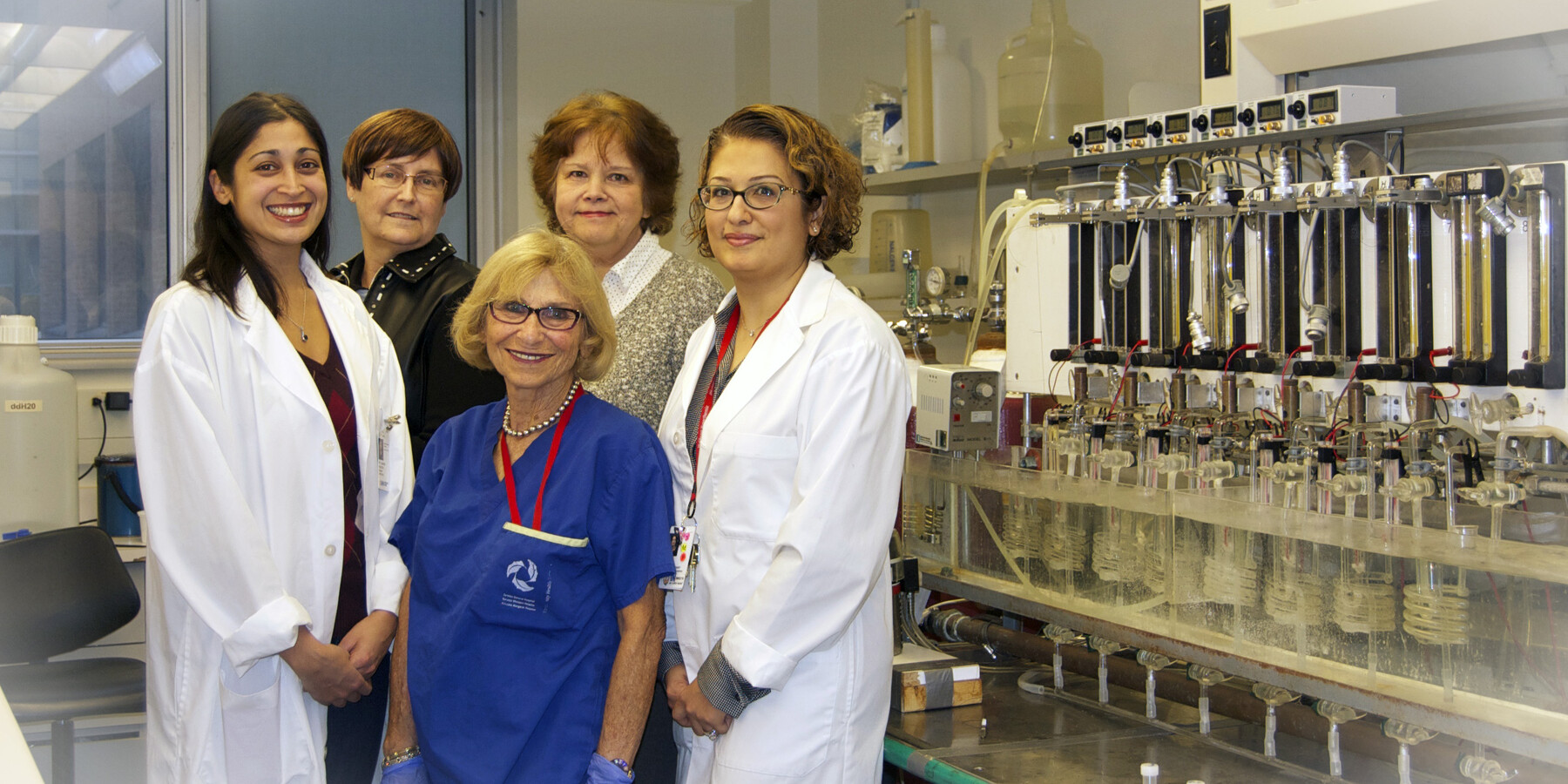Dr. Sheila Riazi

Lab Members
- Sheila Riazi, MSc, MD: Principal Investigator
- Carlos A Morreno Ibarra, MD, PhD: Principal Investigator
- Iqra Razzaq, MSc: Lab Manager
- Elena Zvaritch, PhD: CHCT Technician
- Diann Santiago: Admin Assistant
Contact Us
E: malignanthyperthermia@uhn.ca
P: (416) 340-3128
F: (416) 340-4960
Lab Description
MH investigation unit (MHIU) at Toronto general hospital is a combined diagnostic and research laboratory. The diagnostic aspect focuses on caffeine halothane contracture test (the most sensitive test available for diagnosis of MH). Research aspect includes genetics, metabolomics, and calcium movement in skeletal muscle cells in MH patients, and MH-like syndromes. Our laboratory sees the largest number of MH patients in North America and is the only Canadian center for MH research. Furthermore, our center is the one of the two North American that compiles both genetic and physiological results, allowing us to embark on projects to discover the pathophysiological and genetic causes of MH, and explore the non-anesthetic aspect of MH more at the cellular level.
Research Focus
Malignant hyperthermia (MH) is the only known anesthetic-induced disease. Until recently, MH was considered a pharmacogenetic susceptibility that is subclinical in the absence of anesthetic agents. However, this view has been challenged due to the high incidence of exercise/heat induced rhabdomyolysis, premature ageing and statin-induced myopathy in MH positive patients. The new assessment of MH has brought more attention to investigations of the pathophysiology of MH and its diverse phenotypes. Our group’s research in MH is multifaceted, and focused on different aspects of MH, clinical as well as fundamental, involving genetics and cellular studies. We have one the largest, complete database of patients diagnosed with MH that helps us investigate this disease. We have performed various genetic testing, including exome sequencing on MH patients. We have also focused on details of MH pathophysiology from metabolic changes to calcium movement in these patients. The phenotypic variability among MH patients is believed to cause confusion with diagnosis and treatment, hence the reason for high morbidity, and mortality in this population. Our emphasis on pathophysiological details of MH can shed light to many questions on phenotypic variability in this group of patients.
Selected Publications
- van, Nens van Alfen, Kruijt, N., Erik-Jan Kamsteeg, Fernandez-Garcia, M. A., Treves, S., Riazi, S., Yang, C.-Y., Malagon, I., Lucas, Engelen, van, Scheffer, G.-J., Jungbluth, H., Marc M.J. Snoeck, & Voermans, N. C. (2023). Muscle Ultrasound Abnormalities in Individuals with RYR1-Related Malignant Hyperthermia Susceptibility. 1–14. https://doi.org/10.3233/jnd-230018
- Figueroa, L., Kraeva, N., Manno, C., Ibarra-Moreno, C. A., Tammineni, E. R., Riazi, S., & Rios, E. (2023). Distinct pathophysiological characteristics in developing muscle from patients susceptible to malignant hyperthermia. British journal of anaesthesia, S0007-0912(23)00014-4. Advance online publication. https://doi.org/10.1016/j.bja.2023.01.008
- van den Bersselaar, L. R., Jungbluth, H., Kruijt, N., Kamsteeg, E. J., Fernandez-Garcia, M. A., Treves, S., Riazi, S., Malagon, I., van Eijk, L. T., van Alfen, N., van Engelen, B. G. M., Scheffer, G. J., Snoeck, M. M. J., & Voermans, N. C. (2022). Neuromuscular symptoms in patients with RYR1-related malignant hyperthermia and rhabdomyolysis. Brain communications, 4(6), fcac292. https://doi.org/10.1093/braincomms/fcac292
- Tammineni, E. R., Figueroa, L., Manno, C., Varma, D., Kraeva, N., Ibarra, C. A., Klip, A., Riazi, S., & Rios, E. (2023). Muscle calcium stress cleaves junctophilin1, unleashing a gene regulatory program predicted to correct glucose dysregulation. eLife, 12, e78874. https://doi.org/10.7554/eLife.78874
- Gong S, Qian D, Riazi S, Chung F, Englesakis M, Li Q, Huszti E, Wong J. Association Between the FRAIL Scale and Postoperative Complications in Older Surgical Patients: A Systematic Review and Meta-Analysis. Anesth Analg. 2023 Feb 1;136(2):251-261. doi: 10.1213/ANE.0000000000006272. Epub 2022 Nov 29. PMID: 36638509; PMCID: PMC9812423.
- O'Connor, T. N., van den Bersselaar, L. R., Chen, Y. S., Nicolau, S., Simon, B., Huseth, A., Todd, J. J., Van Petegem, F., Sarkozy, A., Goldberg, M. F., Voermans, N. C., Dirksen, R. T., & RYR1 Myopathy Consortium (2023). RYR-1-Related Diseases International Research Workshop: From Mechanisms to Treatments Pittsburgh, PA, U.S.A., 21-22 July 2022. Journal of neuromuscular diseases, 10(1), 135–154. https://doi.org/10.3233/JND-221609
